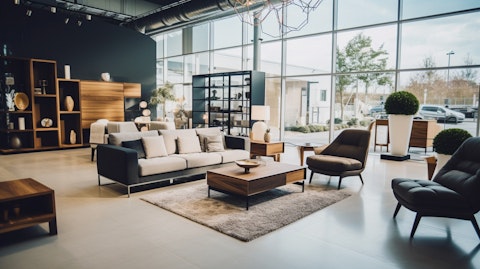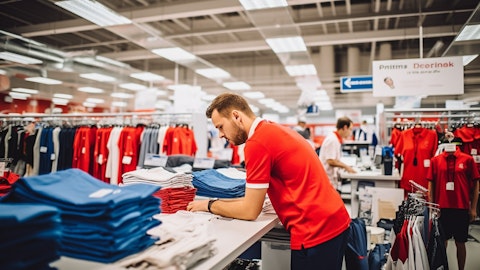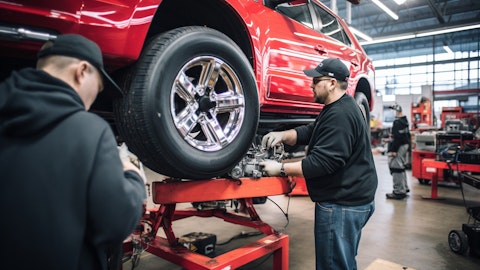Hooker Furnishings Corporation (NASDAQ:HOFT) Q1 2025 Earnings Call Transcript June 6, 2024
Hooker Furnishings Corporation misses on earnings expectations. Reported EPS is $-0.38977 EPS, expectations were $-0.03.
Operator: Good day, and thank you for standing by. Welcome to the Hooker Furnishings First Quarter 2025 Earnings Webcast. At this time, all participants are in a listen-only mode. After the speakers’ presentation, there will be a question-and-answer session. [Operator Instructions] Please be advised today’s conference is being recorded. I would like to hand the conference over to your speaker today, Paul Huckfeldt, please go ahead.
Paul Huckfeldt: Thanks, Kevin. Good morning, and welcome to our quarterly conference call to review our financial results for the fiscal 2025 first quarter, which ended April 28, 2024. Joining me this morning is Jeremy Hoff, our Chief Executive Officer. We appreciate your participation today. During our call, we may make forward-looking statements, which are subject to risks and uncertainties. A discussion of factors that could cause our actual results to differ materially from management’s expectations is contained in our press release and SEC filing announcing our fiscal 2025 first quarter results. Any forward-looking statement speaks only as of today, and we undertake no obligation to update or revise any forward-looking statements to reflect events or circumstances after today’s call.
This morning, we reported consolidated net sales of $93.6 million for the fiscal 2025 first quarter, a decrease of $28 million or 23% as compared to last year’s first quarter. All three reporting segments experienced sales decreases due to lower demand for home furnishings, which is adversely affecting much of the home furnishings industry. Notably, the absence of $7.5 million in revenue from the Accentrics Home product line, which we exited during fiscal 2024, accounted for approximately 25% of the consolidated sales decrease. For the quarter, we recorded a consolidated operating loss of $5.2 million and a net loss of $4.1 million or $0.39 per diluted share. Given the current macroeconomic uncertainty, while we expect to be profitable for the current fiscal year and beyond, we’re taking a hard look at our spending and our fixed cost structure, and we expect to finalize and implement cost reduction plans in the fiscal 2025 second quarter.
We expect to realize a 10% reduction in fixed costs beginning in the second half of fiscal 2025. The cost savings are expected to come from a combination of the consolidation of certain operations and other fixed cost reductions. Now I’ll turn the call over to Jeremy to comment on the fiscal 2025 first quarter results.
Jeremy Hoff: Thank you, Paul, and good morning, everyone. Year-over-year industry-wide US furniture store sales compared to the prior year same month have fallen for 14 consecutive months, as reported by the US Census Bureau. Our first quarter was disappointing as the industry-wide weak demand, which began last year persisted. While we are disappointed to report a rare operating loss this quarter, the loss was almost entirely driven by the sales reductions in each segment, and we strongly believe we’ll return to profitability once demand and revenue rebound, although there may be some short-term volatility in earnings. We remain confident that the strategies we are pursuing in operations, marketing and merchandising are transformative.
Times like these present an opportunity to recalibrate and even reinvent aspects of our business. Despite the current environment, we believe our investments in new showrooms and expanding our addressable customer base and our focus on our strategic initiatives will help us gain market share. Already, we’ve seen a nearly 400% increase in traffic and visibility through our expanded showroom footprints. We see tremendous upside potential to take our flagship Hooker legacy brands, product lines from good to great. The addition of Caroline Hipple to the new position of Chief Creative Officer was extremely well received by our retailers, designers and sales representatives at the recent High Point Market. Her credibility in the industry is significant and her ability to pull people together for collaboration is powerful.
As part of the executive leadership team, she will direct a collaborative merchandising approach across our brands that integrates case goods, upholstery and outdoor furnishings as well as lighting accessories and accents. She leads the most talented team I’ve worked with in my 28-year career in this industry. People always make the difference, which is why we’re so confident in our future growth. As we bring our divisions into full alignment and move forward in the same creative direction inspired by consumer trends in style, materials, color and aesthetics, we can become a whole home resource offering a more forward-facing product line and presentation. As Paul mentioned earlier, the current environment has also necessitated adjustments to our cost footprint to align with current and expected medium-term demand through a strategic realignment of operations.
While we’re still finalizing those plans and expect to have more information sometime in the next quarter, our current projections show a 10% reduction in overall fixed cost, the largest cut in our history. Planned actions include consolidating BOBO into Hooker Branded, further reducing our Georgia warehouse footprint, consolidating certain other operations and additional fixed cost reductions. We’re intensely focused on creating an appropriate expense structure while not jeopardizing the pace and impact of our strategic initiatives, which we believe will have a significant positive impact on Hooker once demand normalizes. We expect to be profitable in the current fiscal year and beyond. Now I want to turn the discussion over to Paul, who will discuss highlights in each of our segments.
Paul Huckfeldt: Thanks, Jeremy. Beginning with the Hooker Branded segment. Net sales decreased $8 million or 18% compared to the prior year first quarter. This decrease was primarily due to decreased unit volume and to a lesser extent, lower average selling prices resulting from price reductions implemented late last year in response to lower ocean freight costs. The soft demand across the home furnishing industry led to a 13% decrease in incoming orders during the quarter, with a corresponding 14% decline in backlog compared to the prior year quarter-end. Quarter-end backlog remains 40% higher than pre-pandemic levels at the end of fiscal 2020 first quarter. At Home Meridian, segment net sales decreased by $15 million or 37% and in the first quarter.

Nearly half of the revenue decline was attributed to the absence of Accentrics Home liquidation sales after exiting that business last year. Excluding the liquidation sales, core sales declined about 17% in the quarter. The remaining decreases were due to lower sales through major furniture change and independent furniture stores, driven by anemic industry demand and lower hospitality sales due to timing of shipments. On a more positive note, fixed overhead costs were reduced by $2 million from business restructuring and reorganization, which included redeploying space at our Georgia warehouse to support Sunset West’s East Coast expansion. Incoming orders decreased by 6% during the first quarter with Samuel Lawrence Hospitality incoming orders more than tripling.
The quarter-end backlog was 22% higher than the same period last year and 37% higher than the fiscal 2024 year-end back in January. The Domestic Upholstery segment net sales decreased by $5 million or 14% in the first quarter due to decreased volume at Bradington-Young, HF Custom and Shenandoah. In contrast, Sunset West experienced a 20% sales increase compared to the previous year first quarter, attributed to its expansion to the East Coast distribution and the stabilization of its new ERP system over the past year. Additionally, Sunset West saw a 9% increase in incoming orders during the quarter and 31% in May. For much of the last year, Sunset West experienced some speed bumps related to the onboarding of the new computer system and building out the resources and personnel needed to expand its distribution.
We think Sunset West is now beginning to hit its stride for positive trajectory going forward. While incoming orders increased by 2.8% for the quarter, quarter-end backlog for this segment decreased compared to the prior year quarter end, but increased from the fiscal 2024 year-end. Excluding Sunset West, order backlog was 38% higher than pre-pandemic levels. Reviewing our cash, debt and inventory positions. Cash and cash equivalents stood at $41 million at the end of the first quarter, a decrease of $2.3 million from the end of fiscal 2024. During the first quarter, we used cash on hand and the $1.5 million generated from operating activities to fund $2.5 million in cash dividends, $1.3 million to further develop our cloud ERP system and $800,000 in capital expenditures.
In addition to the cash balance, we have an aggregate $28.3 million under our existing revolver and $28.7 million in cash surrender value of company-owned life insurance policies outstanding at the end of the year. Given the uncertainty in the furniture industry and the general economy, our short-term capital allocation strategy is focused on preserving capital until we begin to see an industry turnaround while also protecting our 50-year-plus history of quarterly dividends and continuing to invest in our organic growth initiatives. We believe we have a conservative balance sheet, which can help us weather the current demand environment, but we understand the need for caution in a cyclical industry like ours. Now, I’ll turn the call back to Jeremy for his outlook.
Jeremy Hoff: Thank you, Paul. Economic indicators remain mixed with unemployment continuing under 4% and inflation easing slightly in April, leading to a record stock market performance in mid-May. However, the Consumer Sentiment Index fell 10% in May after holding steady for months, indicating a deterioration in optimism across age, income and education levels. Additionally, in both March and April, existing home sales decreased year-over-year. We believe the stagnant home sales are driven by ongoing interest rates and low supply of housing as housing inventories are well below pre-COVID levels. Until the Federal Reserve moves to cut interest rates, we believe the housing industry and therefore, home furnishings demand will remain subdued.
We continue to believe the investments and process improvements we made in the past year will be a springboard to higher sales and profitability. Examples of these investments and improvements include the comprehensive repositioning of Home Meridian with the ultimate goal of sustainable profitability when demand returns to normal levels, along with the continued refinement of our strategy as well as the transformative approach to merchandising we plan to launch across Hooker Legacy Brands. Since many fundamentals of the economy are solid and our company is well positioned, we believe we will benefit from an upturn in consumer confidence and industry-wide demand when it occurs. Compared to fiscal year-end in late January, our consolidated backlog is up approximately 19% through the first quarter, and consolidated orders increased by 11% with orders up across every segment as compared to the previous quarter.
We are encouraged by these increases. This ends the formal part of our discussion. And at this time, I will turn the call back over to our operator, Kevin, for questions.
Operator: [Operator Instructions] Our first question comes from Anthony Lebiedzinski with Sidoti & Company. Your line is open.
Anthony Lebiedzinski: Good morning, and thank you for taking the questions. So first, just coming off of — I’ll ask more of a forward-looking question, I guess, first, given the timing of your call. So Memorial Day just happened not that long ago. Just curious as to what you’re seeing from, or hearing from your retail partners in terms of Memorial Day sales, which traditionally has been a big holiday for furniture buying.
Q&A Session
Follow Hooker Furnishings Corp (NASDAQ:HOFT)
Follow Hooker Furnishings Corp (NASDAQ:HOFT)
Receive real-time insider trading and news alerts
Jeremy Hoff: Yeah, good morning, Anthony. So, fairly positive comments from our retail partners. I wouldn’t call it back to normal type of sentiment, but it seems like it’s a little better than what it’s been, which has been tough, is how I would describe it.
Anthony Lebiedzinski: Okay, that’s good to hear. All right, and so — and I guess, also, in terms of the previously announced growth initiatives, now with the addition of Caroline Hipple, has your thinking, Jeremy, changed in terms of the magnitude of some of those growth initiatives or the timing of those? I know you previously talked about expanding the interior design sales, e-commerce, Sunset West, which looks like that particular brand is doing well. But just overall, maybe help us understand as far, obviously we know it’s a difficult environment now, but as you added some new talent at the top, how are you thinking about the trajectory of some of these growth plans going forward?
Jeremy Hoff: Well, I’ll be in position to answer that a little more specifically in the coming weeks. But for now, I will tell you that any type of slowdown like we’re in right now changes the trajectory on some of those initiatives and we’re working on exactly what that means.
Anthony Lebiedzinski: Okay, got you. Okay. And then I guess, in terms of the cost reduction plans that you talked about, how should we think about the quarterly progression of these cost reductions by quarter in the second half? Is there a specific dollar amount that you can speak to as far as those costs are involved as we looked up at our financial models?
Paul Huckfeldt: On a run rate basis, we’re looking at about 10% of — our fixed overhead is around $100 million. And on a run rate basis, we expect that to be about a $10 million cost reduction. Timing-wise, I would say there will be — some will happen in the second quarter, but third and fourth quarter, we should realize the better part of that. I think about $5 million for the remainder of the year, probably split mostly evenly between the third and fourth quarters.
Anthony Lebiedzinski: Okay, that’s very helpful, Paul. Thanks for that. And then I guess, two other quick questions here, I guess, for me before I pass on to others. So, Jeremy, I know you’ve done a lot to improve HMI, certainly, but strategically, what are you thinking longer term with this segment?
Jeremy Hoff: Well, first of all, you’re right. We’ve been trying to do a lot of things to create a structure for the current business and what we feel that business should be from a support stand, overseas, whether that be warehousing. We’ve got — we’re really very focused, as I’ve said, on the core brands, being Pulaski, Samuel Lawrence, PRI, and then of course our hospitality division. And we believe, and Paul mentioned, we were down I think 17% if you take all the closeouts out of our number in the first quarter. And that’s more in line with, I believe, where the industry is. So we’re really optimistic on the placements we’ve been able to get with new products, and we think it’s really headed in the right direction. And we think we have a cost structure that is really going to be correct for that growth and give us a chance to really be successful on the bottom line.
Anthony Lebiedzinski: Got you. Okay. And last question, just looking at the balance sheet, you guys have $22.5 million of your debt in the current portion of your debt. So how are you thinking about this? Do you expect to refinance that? Or what are your thoughts there?
Paul Huckfeldt: Well, the debt’s current — I mean, it’s going to come out in a few anyway, but we missed it. Because of the operating loss, we’ve missed one of our covenants. So while we’re working with the bank, technically that’s — accounting rules require us to report that as current. We fully expect — and the bank is working with us. We fully expect to revise that credit agreement. We’re not sure exactly how we’re going to do that yet. We’ve got several options that we’re looking at. And so we expect to be back in compliance and we’ll shift back to the former presentation of about $1 million, a little over $1 million in current and the remainder back in non-current starting next quarter.
Anthony Lebiedzinski: Got it. Okay. Well, thanks very much guys and appreciate it and best of luck.
Jeremy Hoff: Thanks, Anthony.
Operator: Our next question comes from Dave Storms with Stonegate. Your line is open.
Dave Storms: Good morning.
Paul Huckfeldt: Good morning, Dave.
Jeremy Hoff: Good morning.
Dave Storms: Just wanted to touch on volumes and pricing. It looks like it’s kind of the same story as last quarter with volumes being the driver and pricing still holding up. How comfortable are you with the pricing overall given the macro backdrop? Is there any pressure to capitulate on pricing a little bit?
Jeremy Hoff: No, we really don’t believe we’re in a position where our pricing is an issue across our brands. In fact, we believe we’re at a pretty significant value. It’s just we need the consumer demand to normalize in order for that to happen.
Paul Huckfeldt: And discounting typically, I mean, we do normal discounting, but we don’t think that discounting is necessarily the way to drive significant demand without just pulling demand forward.
Jeremy Hoff: Correct.
Dave Storms: Understood. Very helpful. And then with the current macro backdrop, should we still expect typical seasonal trends for the year or are you seeing anything that may throw a wrench in those typical trends?
Jeremy Hoff: Right now, I would say that we’re expecting some normal seasonal trends throughout the year until the industry or the economic environment shows us differently.
Dave Storms: Very helpful. Thank you. And then just last one on the showrooms, it’s great to see that foot traffic seems to be consistently increasing. How are you tracking the transition from foot traffic to orders or is it still kind of too early of an inning to really be thinking about it?
Jeremy Hoff: It’s a really good question because step one was getting the exposure visibility like we’ve talked about. Our entire focus right now is on conversion and it’s what you’re asking about. So there’s a lot of ways we are trying to do that, but we believe seeing as many customers or potential customers that we’ve seen, our execution on the conversion is going to be a big key to our growth. That’s why we’re highly focused on that initiative.
Dave Storms: That’s very helpful. Thank you for taking my questions and good luck in the second quarter.
Jeremy Hoff: Welcome. Thank you.
Operator: Our next question comes from Budd Bugatch with [Bentley Blue WTR] (ph). Your line is open.
Unidentified Analyst: Good morning, Jeremy. Good morning, Paul. Thank you for taking my questions.
Jeremy Hoff: Yes, sir. Good morning.
Unidentified Analyst: Good morning. I just want to make sure I hadn’t misinterpreted language in the release. The backlog at the end of the first quarter, if I calculated looking at 19% above the end of the year, that gets to be about an $85.5 million overall backlog. Is that the right way to read it?
Paul Huckfeldt: That’s correct, Budd.
Unidentified Analyst: Okay. And we’ll get the segment numbers when you release the Q?
Paul Huckfeldt: Yes.
Unidentified Analyst: And you said, again, I want to make sure I understand the order comparisons versus last year because the numbers that I’m looking at don’t necessarily compare with what I heard. How was the order book for the first quarter versus the order book for last year’s first quarter? What was the percentage change?
Paul Huckfeldt: Incoming orders are down 6%.
Unidentified Analyst: 6%?
Paul Huckfeldt: Yes.
Unidentified Analyst: Okay. All right. Thank you. And you said you expect to be profitable for the year and for the, obviously, the years afterwards. And I certainly hope that’s correct. Any hazard on when that profitability returns to the operating line or to us?
Jeremy Hoff: There’s some volatility as I mentioned in my part of the call in the shorter term. So we feel better definitely right now about our second half than we do the first half.
Unidentified Analyst: Yeah. And the second quarter last year was a $97.8 million overall revenue, right? That’s correct?
Paul Huckfeldt: Sounds right.
Jeremy Hoff: That’s correct.
Unidentified Analyst: Do you think you’ll be up year-over-year if you had incoming orders up?
Jeremy Hoff: I don’t think we’re in position to say that at this point.
Paul Huckfeldt: Yeah, a little early in the quarter.
Jeremy Hoff: Yeah.
Unidentified Analyst: So — okay, so, okay. So I understand. I appreciate that and good luck on the year. And I understand the industry is challenged right now. So, hope that’s [indiscernible].
Jeremy Hoff: Appreciate that. Thank you, Budd. Thank you, sir.
Operator: [Operator Instructions] And I’m not showing any further questions at this time. I’d like to turn the call back over to Jeremy Hoff for any closing remarks.
Jeremy Hoff: I would like to thank everyone on the call for their interest in Hooker Furnishings. We look forward to sharing our fiscal ‘25 second quarter results in September. Take care.
Operator: Ladies and gentlemen, this does conclude today’s presentation. You may now disconnect and have a wonderful day.
Follow Hooker Furnishings Corp (NASDAQ:HOFT)
Follow Hooker Furnishings Corp (NASDAQ:HOFT)
Receive real-time insider trading and news alerts





